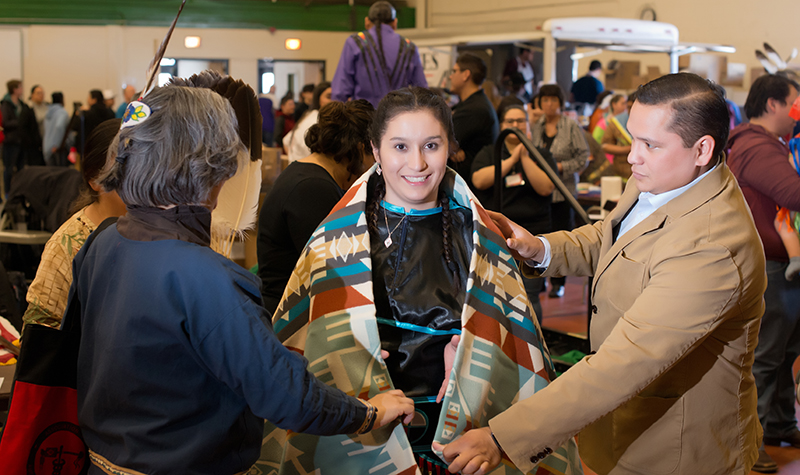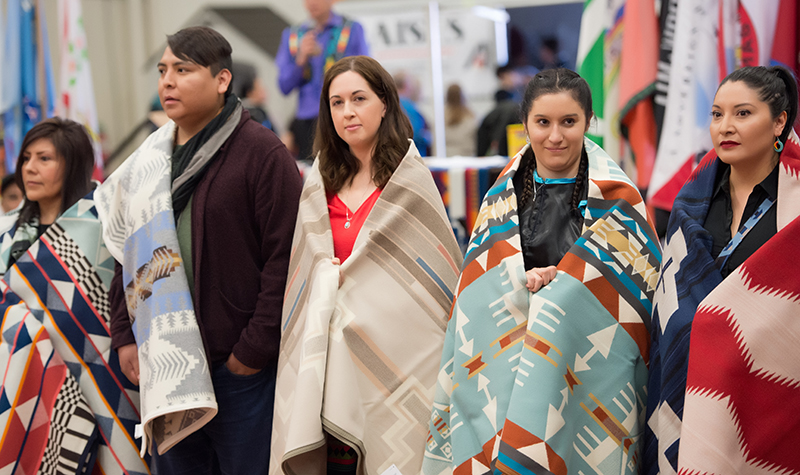Congratulations, Doc
Quartet of INMED medical students graduate this week with intentions of serving and giving back to Native American communities

In the center of Hyslop Sports Arena, at what was once a basketball court, stood seven students as ornate blankets draped their shoulders and drums resounded.
Around them, amid the revelry of Time Out Week’s marquee pow wow in mid-April, people awaited a chance to approach them, shake their hands and congratulate them.
This Sunday, four of the students will graduate as doctors of medicine from University of North Dakota School of Medicine & Health Sciences (SMHS) – an attainment touted with a blanket ceremony, a Native American honor ritual.
“Being able to say I am a doctor,” exalts Mylan Panteah, one of the four budding physicians. “Not very many people get to say that. Not very many people of color get to say that. Within that, not many Navajo people can say, ‘I am a doctor.’ So, getting to this point is a really proud moment.”
Panteah, who was born in the Navajo Nation and raised in New Mexico, belongs to the most recent graduating cohort of the Indians Into Medicine (INMED) program at UND. So do Jessica Johnson, Shyleen Hall and Ciciley Littlewolf.
Founded almost half a century ago, the INMED program, currently led by Don Warne, has supported and trained over 240 Indigenous physicians across the country.
“Native Americans have lower rates of graduating high school, let alone college,” said Hall. “Just the fact that you are graduating with a bachelor’s degree is a big achievement. Master’s degree, there is even fewer [of us]. With a doctorate [degree], [the number] just goes down.”
In spite of stats
At every academic level, Hall, who hails from Belcourt, North Dakota, has bucked the statistics. As an INMED undergraduate at UND, she studied biology before obtaining a master’s degree in public health. At a pow wow before every graduation, Hall has received an honorary blanket.
“Each one was special,” she said. “I am happy that will be my last time graduating.”
Hall is to cross the stage at the MD Commencement Ceremony on May 12. This moment is to conclude four years of lectures, exams and rotations, which began with a baby.

Three weeks before Hall started medical school, she and her husband, Shaun, welcomed their first daughter, Carol.
“Looking back at it, I think I would cry every eight weeks,” Hall said. “It happened every time before exam week, but it got better by the second year. You get used to doing [the exams].”
Hall’s mother, a nurse in Belcourt, would lend a hand, too, in caring for Carol.
By the middle of her third year, which ushered in mandatory rotations at Altru Health System in Grand Forks, Hall had her second daughter, Kennedy.
Balancing family and medicine proved, at times, tough, but it ultimately made Hall a better doctor, she said.
“I want to be able to be a role model for other people, especially people from back home and let them know that this is possible,” Hall said. “You can achieve your dreams. This is my dream and I have almost achieved it. I want to let people know that they can do it. You can have a family while you do it, too.”
But Hall intends to be more than an exemplar for Native American communities. After a three-year family medicine residency at Altru, when the service tenet of her Indian Health Services (IHS) scholarship kicks in, she is set to be a healthcare provider to Indigenous people as well.
“With family medicine, I can deliver babies, I can take care of the babies, I can take care of older people,” she said. “I can take care of anyone pretty much.”
Service and research
Panteah is also specializing in family medicine and its practice in rural locales that are often home to Native American populations. It was the possibility to do clinical rotations away from a bustling city – through the Minot Integrated Longitudinal Experience – that lured him to UND SMHS in the first place.
“I plan to go back to a tribal hospital or an IHS hospital to help those areas that need a lot of doctors and physicians to work there,” he said. “That was always my plan – to go back to my own community and work as a physician.”
Panteah’s bent for the medical profession stems from a paternal lineage of traditional healers. Yet, he aspired to blend that ancestral knowledge with Western practices. Panteah, who obtained a biology degree at New Mexico State, also yearned – and still does – for research – a proclivity not entirely common or even feasible for medical students.
“I had a lot of research experience prior to med school and it was something that I wanted to continue and want to continue after med school as a physician,” he said.
Panteah’s cancer research with Joyce Ohm, former assistant professor of biochemistry and molecular biology at UND, culminated in a publication as well as an Alan Allery Graduate Research Award for him.
When he received it back in 2016, Panteah was among the first students to be ever nominated for the distinction, which recognizes research that promotes Native American health and well-being.

Early-age vocation
In an aspect different from Panteah’s, Ciciley Littlewolf reached a first as well. When she interviewed for medical residencies, she learned she was the sole Native American physician with the North Dakota Army National Guard.
“I am extremely proud of that,” she said. “I hope to be a role model for other soldiers, other Native American soldiers, specifically, to continue to move forward in their careers and be the best soldiers they can be.”
Littlewolf, who is to soon delve into internal medicine at Sanford in Fargo through UND’s residency program, knew she wanted to be a doctor from a tender age.
Although the roots of her fascination with medicine escape her, she recalled an instance when, as a 5- or 6-year old, she donned her mother’s white work blazer, which seemed to engulf her tiny frame, and pretended to be a physician.
“I didn’t think it was impossible,” said Littlewolf, who grew up on the Northern Cheyenne Reservation in Montana before relocating to Vermillion, South Dakota. “I just wanted to be one.”
Having witnessed the perseverance of her mother, who went to college in her late 30s in order to better support her six children, Littlewolf earned two bachelor’s degrees – in criminal justice from University of South Dakota and zoology from North Dakota State – before she arrived at SMHS.
Here, the INMED staff and students welcomed her home, she said.
Family support
Jessica Johnson, who comes from Kansas City, echoed that assertion. Some 600 miles away from her family, the friendships she fostered through INMED bloomed invaluable support and motivation.
“The INMED program has been so amazing and [has provided] that family feel and also so many opportunities,” Johnson said.
When she stepped on UND’s campus for her INMED interview one January day some four years ago, she did not think she would ever return. There were 20 candidates vying for seven INMED SMHS spots.
Today, less than a week away from commencement, where her fiancé will hood her, Johnson looks back with justifiable pride.
“[R]egret and not living up to my expectations don’t sit well with me,” she said. “I am very glad that I had the persistence to stick with it. It is a very long process and you have to take it one step at a time.”
Those single steps included a bachelor’s degree in biology, gigs as an emergency room scribe and, later, assistant in a pathology lab as well as an initial shot at medical schools that landed her on a wait list.
After a giant bound with the SMHS, next for Johnson is a pediatrics residency at the University of Missouri, where her fiancé is an anesthesia resident. Afterwards, she will seek a job with a tribal or IHS facility.
“Pediatrics is much more of an art of medicine than other specialties I was introduced to,” Johnson said.
For Johnson, who is Seminole and Creek, pediatrics also offers a conduit to aid disadvantaged Indigenous children in ways that transcend routine checkups.
“I didn’t grow up on a reservation, but I grew up in an affluent suburb of Kansas City and had a wonderful childhood,” she said. “Going into [pediatrics] is an opportunity to give my patients as many opportunities physically, emotionally and mentally as I had [in order] to decrease the healthcare disparities that we have in Native American communities.”


